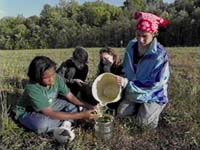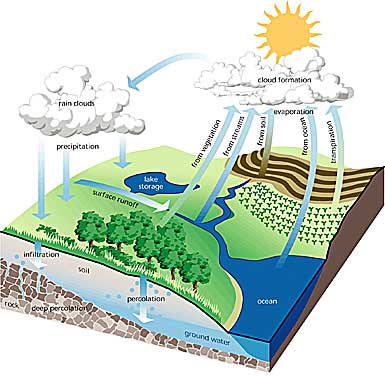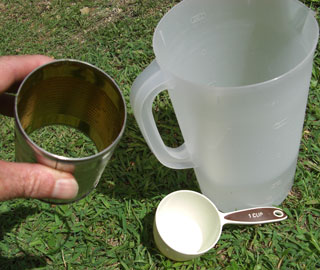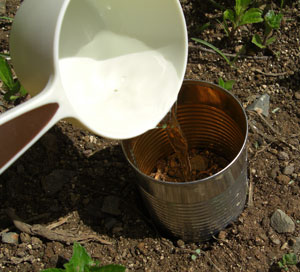
| Soil infiltration refers to how fast water soaks into the soil. It turns out to be a very important property of soils that affects vegetation growth, recharge of aquifers, stream flow, and soil erosion. |
 |
Purpose: Introduce the concepts of soil water infiltration and the soil water balance. Study the factors that affect infiltration, practice taking environmental measurements, understand effect of land use practices on recharge and runoff.
In this lab you will determine the approximate infiltration rate of water into soils under various conditions, determine how surface conditions affect the infiltration rate, and speculate how change in surface conditions might affect other hydrologic variables.
 Background
Background
The infiltration rate is an important component of the hydrologic cycle of watersheds (shown in the diagram). It helps determine how rainfall is divided between recharging the groundwater and running off as sheetwash and in streams. The following relationships apply:
Many things can affect the infiltration rate, including soil grain size, vegetation cover, air voids, biotic activity (like worms), and mulching. One of the greatest environmental problems resulting from deforestation has been a huge increase in soil erosion: not only do plants slow down runoff so that it has more time to soak into the soil, but the roots aerate the soil, giving water tiny tube pathways as infiltration channels. When the plants are gone, there is little to slow the water from flowing over the surface and carrying soil with it. Other problems include increased flash flood hazard, increased sediment in rivers, and reduced river flow during dry seasons.
Materials needed
1. a 14.5 ounce tin can with both top and bottom removed. Try to find a can with a rim ridge around both the top and bottom or your can opener might not be able to open the bottom
2. a one cup (8 ounce) measuring container
3. a water source or bucket of water
4. a watch, stop watch, or cell phone that shows seconds
5. you may need a trowel, old knife, screwdriver or other tool to loosen soil, especially for compacted soil.
6. a ruler or tape measure to determine water depth for other compacted soil test
Procedure for determining the Infiltration Rate
One cup of water will a standard 14.5 ounce tin can to a depth of about 60 millimeters. This value has already been entered in Table 1 below.
Measure the time in seconds required for the water to soak into the ground at the first three test sites and the depth of water remaining in the can after 120 seconds at the fourth.
CAREFUL! Try not to let water seep out from under the edge of the can to ensure that it soaks into the soil and you get a true measurement. A very small amount of leakage is acceptable. Again, the water will infiltrate quickly in some, but not all, areas.
 |
 |
Questions to Answer:
Question 1. Location and Measurement . Record the date, time, location, and sky conditions and fill in values for the table below. Include the completed table in your writeup.
Date _____________________________
Time _____________________________
Location __________________________
Sky Conditions _____________________
Measurement. Fill in Table1 with infiltration times at the first 3 sites and the water depth drop after 120 seconds for the 4th, compacted soil. Then calculate the infiltration rates in millimeters per second. SHOW YOUR DATA for Table 1 in your writeup.
One cup of water will fill a standard 14.5 ounce can to a depth of about 60 mm, this value is shown in Column 1. Fill in the remaining blanks in the table.
1 |
2 |
3 (Col 1 / Col 2) |
|
| Location | Water Depth (mm) |
Time (seconds) |
Infiltration
Rate (mm/second) |
| Gravel or Lava Rock | 60 |
||
| Natural Area (like forest or deep mulch, NOT mowed grass) | 60 |
||
| Loose Soil | 60 |
||
| Compacted Soil | 60 - ______ = _______ |
120 |
|
| Concrete or Asphalt | 0 |
120 |
0 |
Question 2. Compare infiltration rates.
A. Grain Size:What were the infiltration rates for gravel (large grain size) and loose soil (small grain size)? Which had higher infiltration rates and by how much (either in mm/sec or as a multiple).
B. Compaction:What were the infiltration rates for compacted soil and loose soil? Which had higher infiltration rates and by how much (either in mm/sec or as a multiple).
C. Vegetation:What were the infiltration rates for natural area and loose soil? Which had higher infiltration rates and by how much (either in mm/sec or as a multiple).
Question 3. What affects the infiltration rate? Name two factors that could affect the infiltration rate and explain how and why they would affect it. (This is easier than you think, just use common sense. What would cause more water to soak into the soil and why?)
A. _______________________________________________________________________________________
B. _______________________________________________________________________________________
Question 4 . Hawaii. List some areas of Hawaii that might be similar to the surfaces you measured. Give at least two examples each.
Gravel (lava rock) _______________________________________________________________
Natural Area (forest) _____________________________________________________________
Loose Soil (agriculture) ___________________________________________________________
Compacted Soil ________________________________________________________________
Concrete and Asphalt ____________________________________________________________
Question 5 . Calculations. Assume that it rains 1 mm per second. Calculate the rate and amount of runoff using the simple equation below. NO NEGATIVE VALUES, if your calculation comes out negative, enter zero (0). (show your work)
Rainfall is 1 mm/sec, Infiltration is from Table 1 above, calculate Runoff using:
Runoff = Rainfall - Infiltration
For example, if the infiltration rate is 0.3 mm/sec, then Runoff = 1 - 0.3 = 0.7 mm/sec
Gravel, rate of Runoff (mm/sec) = _____________________________
Natural Area, rate of Runoff
(mm/sec) = _______________________
Loose Soil, rate of Runoff (mm/sec) = ______________________________
Compacted Soil, rate of Runoff (mm/sec) = ___________________________
Concrete/Asphalt, rate of Runoff
(mm/sec) = _______________________
If it rains steadily for 10 seconds, what will be the total runoff (in mm)? To answer, multiply the above runoff rates (in mm/sec) by 10. Again, the answer cannot be negative, nor can it be more than 10 mm.
Gravel, runoff total (mm) = _____________________________
Natural Area, runoff total (mm)) = _______________________
Loose Soil, runoff total (mm) = ______________________________
Compacted Soil, runoff total (mm) = ___________________________
Concrete/Asphalt, runoff total (mm) = _______________________
NOTE: this exercise is greatly simplified, but helps to demonstrate the basic relationships between water balance variables.
Question 6 . Water Balance. Determine the amount of Recharge for each land use scenario in Table 2 below. For the runoff, fill in the Runoff column using values you calculated above for 10 seconds of rain. Again, NO NEGATIVE VALUES, if your calculation comes out negative, enter zero (0). Also, if Evaporation + Runoff exceeds 10 mm, then reduce Runoff accordingly.
Use the equation given at the beginning of this lab: Rainfall = Runoff + Recharge + Evaporation
| Surface type | Rainfall (mm) |
Runoff |
Recharge |
Evaporation |
| Lava Rock (gravel) | 10 |
0 |
||
| Forest (natural area) | 10 |
3 |
||
| Farmland (loose soil) | 10 |
2 |
||
| Compacted Soil | 10 |
1 |
||
| Urban (concrete/asphalt) | 10 |
0 |
A. Based on Table 2 above, which surface types in Hawaii appear to provide the MOST recharge to the groundwater aquifers?
Name a couple of specific places as examples _________________________________
B. Based on Table 2 above, which surface types in Hawaii appear to provide the LEAST recharge to the groundwater aquifers?
Name a couple of specific places as examples _________________________________
Review your answers for #5 and #6. Are there any negative numbers or numbers greater than 10? If so, read carefully and recalculate.
Question 7. Land Use Scenarios. Based on the values you measured and calculated in Tables 1 and 2 , speculate on how you think the following land use changes might affect the soil infiltration rate and the balance between runoff and recharge in Hawaii, and what environmental consequences there might be. Environmental consequences are discussed as the beginning of the lab and you can also do an internet search.
A. Conversion of natural, forested land to farmland (loose soil)
How would this affect infiltration rate, runoff and recharge (look at your tables)?
Would be the likely environmental consequences of this conversion?
B. Conversion of farmland (loose soil) to urban (housing, asphalt, concrete, compacted soil)
How would this affect infiltration rate, runoff and recharge (look at your tables)?
Would be the likely environmental consequences of this conversion?
These are relevant issues, especially on Oahu where the aquifer is being pumped at near its maximum sustainable capacity.
C. Based on your findings, suggest two ways to increase recharge on Oahu.
D. Based on your experience in this lab, why do you think that the forested mountain areas are designated "Soil and Water Conservation Districts" and protected from development in Hawaii?
Question 8 . Problems. Please tell me about how long it took you to complete this lab and what significant problems you had.